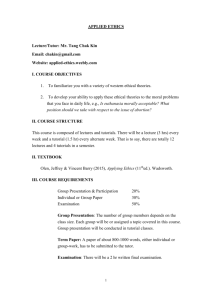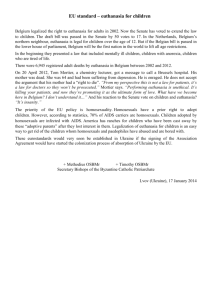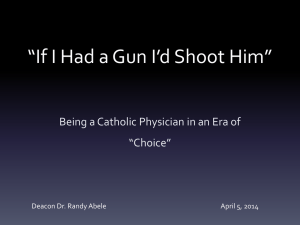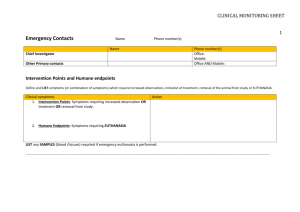A Social Justice Value Approach Regarding Physician
advertisement
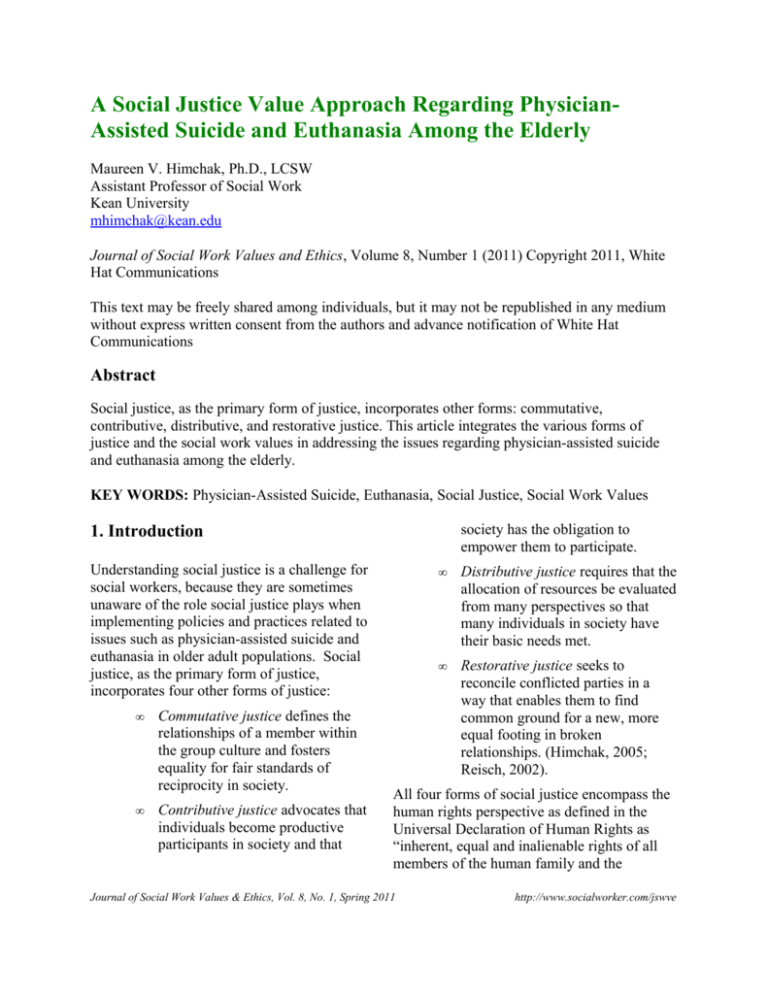
A Social Justice Value Approach Regarding PhysicianAssisted Suicide and Euthanasia Among the Elderly Maureen V. Himchak, Ph.D., LCSW Assistant Professor of Social Work Kean University mhimchak@kean.edu Journal of Social Work Values and Ethics, Volume 8, Number 1 (2011) Copyright 2011, White Hat Communications This text may be freely shared among individuals, but it may not be republished in any medium without express written consent from the authors and advance notification of White Hat Communications Abstract Social justice, as the primary form of justice, incorporates other forms: commutative, contributive, distributive, and restorative justice. This article integrates the various forms of justice and the social work values in addressing the issues regarding physician-assisted suicide and euthanasia among the elderly. KEY WORDS: Physician-Assisted Suicide, Euthanasia, Social Justice, Social Work Values society has the obligation to empower them to participate. 1. Introduction Understanding social justice is a challenge for social workers, because they are sometimes unaware of the role social justice plays when implementing policies and practices related to issues such as physician-assisted suicide and euthanasia in older adult populations. Social justice, as the primary form of justice, incorporates four other forms of justice: • Commutative justice defines the relationships of a member within the group culture and fosters equality for fair standards of reciprocity in society. • Contributive justice advocates that individuals become productive participants in society and that • Distributive justice requires that the allocation of resources be evaluated from many perspectives so that many individuals in society have their basic needs met. • Restorative justice seeks to reconcile conflicted parties in a way that enables them to find common ground for a new, more equal footing in broken relationships. (Himchak, 2005; Reisch, 2002). All four forms of social justice encompass the human rights perspective as defined in the Universal Declaration of Human Rights as “inherent, equal and inalienable rights of all members of the human family and the Journal of Social Work Values & Ethics, Vol. 8, No. 1, Spring 2011 http://www.socialworker.com/jswve foundation of freedom, justice and peace in the world” (U.N. General Assembly Preamble, 1948, p. 1; Axin & Stern, 2006). Within the last decade, the social work profession has adopted the human rights perspective as the basic principle undergirding the formulation of social work policy in designing programs, the implementation for social work practice in services and the utilization of theory-based research methodology (NASW Code of Ethics, 2003). Since social justice is the overarching value, this article integrates social work values and end-of life decisions with various forms of justice. It also addresses these forms of justice in relation to several issues that are major concerns among the elderly. These issues are individual and cultural autonomy, family autonomy and decision-making, ethical dilemmas for health care professionals, and the legalization of euthanasia and physicianassisted suicide. Physician-assisted suicide and euthanasia are rapidly becoming serious ethical dilemmas in all aspects of society, primarily because of advanced medical technology that rather easily allows the prolongation of life. Hence, complex ethical issues regarding physicianassisted suicide and euthanasia emerge not only among medical people, but also among the religious, legal, and social work professions, as well as the general population. There is a shift in attitudes regarding physician-assisted suicide and euthanasia. Public opinion polls, for instance, conducted from 1936 to 2002 found that Americans radically changed their attitudes regarding both physician-assisted suicide and euthanasia (Allen et al., 2006; Emanuel et al., 2000; Logue, 1993). The shift is largely due to the belief that individuals have the right to end their lives when they perceive their quality of life is significantly diminished and/or when invasive medical innovations that prolong life become too financially costly (Allen et al., 2006; Emanuel, 2002; Logue, 1993; Loewy & Loewy, 2002). Although policies concerning physicianassisted suicide and euthanasia affect all populations, this article focuses specifically on the geriatric population, because they are the fastest growing vulnerable group of Americans with the greatest numbers consisting of the frail elderly, 75-85 years of age. By 2030, the number of older persons (aged 65 years and older) in the United States is projected to increase to 66 million, making the issues of assisted suicide and euthanasia more prominent (U.S. Census, 2000). The majority of this population includes culturally diversified women who are widowed, living on limited incomes, and living with functional disabilities. Although Caucasian older adults continue to represent the majority of the aged population, minority elderly groups are growing rapidly. By the year 2050, there will be 22 million minority elderly (U.S. Census, 2000), most of whom will be AfricanAmerican, Hispanic, and Asian (Angel & Hogan, 1992). 2. Distinctions and Terms Before entering the heart of this article, it is essential to define the relevant terms, which are often muddy in popular literature. First among the concerns is understanding of death, especially as different people in different cultures perceive it. In general, individuals and societies envision death in three ways: as the antithesis of life, as a part of life, and/or as the end of life. Thanatology is the study of death and death related behavior, and orthothanasia is the science of dying a natural death. Religious and cultural beliefs; science and medical technology; and the ethics and values of the medical, legal, and social work professions (Pellegrino, 2001) have influenced both Journal of Social Work Values & Ethics, Vol. 8, No. 1, Spring 2011 http://www.socialworker.com/jswve concepts. Both concepts are at the core of the euthanasia and physician-assisted suicide debate. • The word “euthanasia” originates from the Greek language meaning "good death": eu, well; thanatos, death (Beauchamp & Childress, 2001). A good death requires that the individual has clarity in decision making and self-awareness in accepting death (Cameron, 2002). In today's society, the word euthanasia generally means the act of taking a terminally ill person's life for merciful reasons, generally known as "mercy killing" (Porter & Warren, 2005; Marker, 2006). However, physician-assisted suicide refers to a physician providing the means (such as medication or other interventions) of suicide to a competent patient who is capable of carrying out the chosen intervention (Allen et al., 2006; Gesundheit et al., 2006; Marker, 2006). In considering, euthanasia as a good death, the individual needs to understand and accept the fact that physician-assisted suicide and euthanasia terminate life, but it might not be a good death (Pellegrino, 2001). • • voluntary, i.e. with the consent of the person, involuntary, i.e. against the expressed will of the person, non-voluntary, i.e. when it is not possible to obtain consent because of the incapacity of the person (Chaloner, 2007; Ersek, 2005; Gesundheit et al., 2006; Porter & Warren, 2005). 3. Active and Passive Euthanasia Whereas failing to be precise in the use of terminology often causes confusion about the moral justification of the practice of active and passive euthanasia, the differences between active and passive euthanasia are not a mere matter of “semantics.” Rather, they are based on the objective reality of three factors: cause, motive, and means (Atkinson, 1983; Gesundheit et al., 2006). In the case of the terminally ill person, some argue that the ultimate cause of death is the disease or illness, and active euthanasia is just hastening the death process. Whereas the ultimate cause of death in active and passive euthanasia may be the disease or The difficulty regarding the right to die is illness, there are major differences between further confused by the failure to understand the them. In active euthanasia, an individual who differences between active and passive, and does something directly to cause the death, voluntary and involuntary, euthanasia and whereas in passive euthanasia the cause of death physician-assisted suicide (Rodgers, 1996; is the natural course of the disease or illness, Shapiro, 1994). First, active or positive brings about death (Atkinson, 1983; Ersek, euthanasia involves a direct action to end a 2005; O’Rourke, 1991). The intention of the person's life for merciful reasons, for example, individual who hastens death is also a by administering a lethal injection. Passive or significant factor in the distinction between negative or indirect euthanasia is the failure to active and passive euthanasia. In active provide necessary care for survival, or the euthanasia, the intention is to directly terminate process of allowing people to die when they the person's life for merciful reasons; whereas, could be kept alive by medical or other the intention of passive euthanasia is to allow interventions (Chaloner, 2007; Ersek, 2005; life to end naturally by natural causes (Chaloner, Gesundheit et al., 2006; Porter & Warren, 2007; Marker, 2006). The practice of passive 2005). Furthermore, both the active and passive euthanasia is generally accepted among the forms of euthanasia can be: general population and among health care professionals, because it allows patients to make choices about life support, such as choosing not Journal of Social Work Values & Ethics, Vol. 8, No. 1, Spring 2011 http://www.socialworker.com/jswve to use life support or choosing to withdraw life support interventions. 1977). The right to life as a predominant right is also a human right, because it is connected with human well-being and belongs equally to The principle of double effect is often at play in all humans (Callahan 1994; Feinberg, 1977). terminal sedation when one intends to relieve The rights of life, liberty, and the pursuit of pain through medication while realizing that the happiness are nontransferable rights, but the medication may also hasten the death. In other right to life is a precondition to the other rights. words, there are two effects from the same act. An action intended to achieve a “good” effect The value of commutative justice from the (such as relieving pain and suffering) is human rights perspective provides a valuejustifiable, despite the possibility of an oriented approach on the autonomous rights of unwanted secondary effect (such as hastening older adults in their attitudes toward physiciandeath) if the intent of the clinicians is the assisted suicide and euthanasia. Commutative “good” effect. For example, if a patient is justice defines relationships among a group’s administered morphine with the intent to relieve members. It respects the individual person’s pain, the action is morally acceptable regardless dignity and worth by seeking equality based of any secondary outcome (Marker, 2006; on fair standards for reciprocity in human Porter & Warren, 2005). relationships. It also rejects the encroachment on others’ rights. From a commutative value4. Individual Autonomy and Rights oriented approach, the social worker in respecting the individuals’ dignity and worth The predominant ethical principle in the not only encourages self-determination of the controversy about physician-assisted suicide and older adults’ choices but also empowers them euthanasia is personal autonomy or the rights of to define themselves as people who have self the individual. Miller (1981) describes three awareness, life plans and values regarding senses of autonomy at work in medical ethics. their choices. It helps them to identify their First, autonomy as free action implies that the conceptualization of death and the underlying action is voluntary and intentional. Second, values regarding end-of-life decisions. autonomy as authenticity implies that the action Utilizing a value-oriented approach in is consistent with the individual’s value system, assessing the older adults’ perspectives of character, and life plans. Third, autonomy as death encourages individuals to create a effective deliberation implies the action is biographical summary of their life and death considered when the individual initiates the history regarding end-of-life decisions. It is decision, has knowledge of the consequences, essential for the social worker to explore the and reaches an informed decision. older adults’ biological and biographical context and meaning of life as well as Two concepts are important when defining exploring all treatment options regarding endautonomy: the right to life as an inalienable of-life decisions. Older adults need to know right, and the right to life as a predominant that they are not only free in making their right. Implied in the basic inalienable rights of decisions, but that they are informed and life, liberty, and pursuit of happiness is the idea understand the consequences of all treatment that these rights are nontransferable and Godoptions (Miller, 1998). given. As an inalienable right, the right to life implies the right to preserve and protect life 5. Autonomy and Culture (Allen et al., 2006; Callahan, 1994; Feinberg, Journal of Social Work Values & Ethics, Vol. 8, No. 1, Spring 2011 http://www.socialworker.com/jswve Commutative justice is considered to be intrinsic to social work, because social workers respect the inherent dignity and worth of all individuals and empower individuals to define themselves in the context of their cultural belief systems. Social workers treat each person in a caring, respectful manner mindful of individual differences and cultural and ethnic diversity. Culture provides a sense of identity for individuals in their affiliation to the group. Whereas culture is usually understood as ethnic affiliation, it also includes one’s religious affiliations, practices, and spirituality (Haley et al., 2002). Research studies (Blackhall et al.,1995; Werth et al., 2002) examined the culture-concept of autonomy regarding medical decision making among four groups of elderly: Asians, Hispanics, African Americans, and European Americans. These studies indicated that although there were differences attributed to religion, gender, and age, ethnicity was the most important factor in making major decisions. Asians and the Hispanics favored a more family-centered model in making medical decisions, whereas African Americans and European Americans favored an autonomous model. Role obligation or filial responsibility was identified as the most significant factor for decision making among the four groups of older adults. Cultural influences regarding physicianassisted suicide and euthanasia are well documented, with studies highlighting different spiritual beliefs concerning disclosure and consent, family decision-making, and treatment decisions (Enes & Vries, 2004). Religion and intergenerational family ties play a major role for African Americans in making decisions regarding physician-assisted suicide and euthanasia. The majority of African Americans adhere to a Christian spirituality, with 83% claiming Protestant affiliation. While the Baptist, 14% identify as Catholic (Ellison & Sherkat, 1990; Enes & Vries, 2004). Documented studies also indicate that Hispanic Americans have strong family and religious ties that urge them to offer instrumental and adult daily living care-giving as well as affective support within the immediate and extended family. This care giving crossed generational and intergenerational lines. In the year 2000, there were about 31 million Hispanic Americans residing in the United States, with one million of these Hispanic Americans age 65 years of age and over. The fastest growing group of Hispanics is the “old old” elderly, people age 85 and over. This will have a great impact on Hispanic adults in the next few decades as they face aging parents, and grandparents. In terms of religious affiliation, most Hispanics identify as Roman Catholic (Bastida, 1988; Cuellar, 1990; Enes & Vries, 2004; Haley et al., 2002). Among Asians, the Chinese are the fastest growing population in the United States (Ferrans & Hsiung, 2007). A large part of this growth is attributed to a lower mortality rate and longer life expectancies for this ethnic group (Ferrans & Hsiung, 2007). Moreover, strong Confucian beliefs that emphasize filial piety and family responsibility affect their view on issues such as physician-assisted suicide and euthanasia (Gelfand & Barresi, 1987; Scharlach et al., 2003; Yeo & Hikoyeda, 1992). Because the Chinese elderly are very concerned about saving face, having respect for their physicians, showing family loyalty, and a sense of duty in completing life tasks, physician-assisted suicide and euthanasia are rarely spoken about. In fact, even discussions about end-of-life treatment options can be interpreted as disrespectful of the elderly in the Chinese-American community (Haley et al., 2002). It is imperative that social workers who work with the elderly and the infirm are ethnically, Journal of Social Work Values & Ethics, Vol. 8, No. 1, Spring 2011 http://www.socialworker.com/jswve culturally, and spiritually competent. They need knowledge and awareness of ethnic beliefs and values before engaging in discussions about physician-initiated suicide, euthanasia, and/or end-of-life decisions when working with older adults. Ethnic and spiritual personal beliefs may or may not be congruent with the predominant ethnic cultural beliefs or the religious doctrines of organized religions, but knowledge of these beliefs will build awareness and sensitivity. The role of the social workers is to prevent and to eliminate domination, exploitation, and discrimination against any person or group on any basis whether cultural, ethnic, or spiritual. 6. Family Autonomy and DecisionMaking All individuals by virtue of their human nature have social needs. Human relationships enable people to meet their needs and provide an important vehicle for change. Autonomous decisions encompass the individual's values in the context of human relationships such as family and friends and involve personal responsibilities to others and to the good of society. Among the elderly population, two concerns are paramount. First, society has the burdensome responsibility of managing the quality of life of the ill and frail elderly while grappling with the escalating costs of health care. Second, many families cannot afford quality health care for their elders and provide much of the care themselves. The care-giving responsibilities for family members are stressful and costly (Haley et al., 2002; Mackelprang & Mackelprang, 2005; Pifer & Bronte,1986). A national study indicated that the burden of caring for the elderly led to depression among family caregivers, especially those caring for terminally ill patients (Emanuel, et al., 2000). Many elderly rely on their families as their major source of care-giving (Circirelli, 1997; Haley et al., 2002). They perceive the interests of family as part of their own interests and are concerned with the impact their decision (about euthanasia or physician-assisted suicide) has upon the family unit (Emanuel et al., 2000; Hardwig, 1990). The complexity of the physician-assisted suicide and euthanasia debate has been heightened by the tension between the competing rights and autonomy of the elderly and their families. In addition, they may feel guilty for considering or promoting euthanasia or palliative care. Contributive justice advocates for the elderly person, the family members, and the health care professionals as participants in determining the treatment options that serve all parties and promote the common good of society. Social workers recognize the value of human relationships as central to the profession (Congress, 1999). Social workers promote the general welfare and development of individuals, families, and communities. Contributive justice is utilized by promoting family autonomy, because family autonomy is based upon a common set of family values that is the common ground for family deliberation and decisions (Thomasma & Graber, 1991). Shared decision-making by the elderly and family members empowers the elderly to develop interdependence rather than dependence. Moody (1988) suggests family negotiation as the process of informed consent in shared dialogue among health care professionals, family members and the patient. Family members list the following issues as central for them when making end-of-life decisions for the elderly with chronic illness: attachment, cultural expectations, and avoiding institutional care (Haley et al., 2002). Individual family members make decisions based on their family values and commitments despite differences and disagreements among family members (Roberto,1999). Family loyalty and respect are the main values for Journal of Social Work Values & Ethics, Vol. 8, No. 1, Spring 2011 http://www.socialworker.com/jswve making end-of-life decisions, regardless of whether the decision was made by the individual for him/herself or for other family members (Leichtentriit & Rettig, 2001). A research study by Terry et al. (1999) indicated that terminally ill patients preferred a proxy’s choices to their own for the following reasons: Many of these patients believed that the proxy’s judgment was better than their own. The relationship between the proxy and the terminally ill patients clouded the judgment of the terminally patients. Trying to please the proxy, the terminally ill patients valued the proxy’s interests as being more important than their own. These reasons were based on emotional attachment and a longstanding history with the terminally ill patients. On the other hand, there are many reasons for decision-making by family members. Among them are one’s concept of family, finances, age and health of the caregiver, geographical proximity, competing obligations, and stress of care giving (High, 2003). Conversely, there are many barriers in making decisions about death among family members, including culture, education, knowledge of the health care system, and the delegating of all decisions entirely to the family (Haley et al., 2002). Social workers seek to strengthen relationships among people at all levels in order to promote their well being. Contributive justice explores the avenues in relationships that empower older adults and their family members to become collaborative participants in making decisions about end-of-life care. Social workers understand that relationships between and among people are important vehicles for change. Therefore, social workers, in developing their expertise, are also challenged by the social work value of integrity that integrates authenticity and trustworthiness in engaging people in the helping profession and in promoting their well being at all levels. This requires that social workers have clarity about their personal and professional value system regarding the issues of physician-assisted suicide and euthanasia. 7. Ethical Dilemmas for Health Care Professionals The dilemma that challenges the health care professionals’ ethics regarding physicianassisted suicide and euthanasia focuses on the following bioethical principles: Autonomy, Beneficence, and Non-maleficence. Arguments favoring physician-assisted suicide and euthanasia include the following: • Autonomy: respects the individual’s right to choose and to make his/her own decisions to preserve free choice and human dignity. • Beneficence: Doing good means helping a suffering patient maintain control and end suffering in a compassionate manner. • Non-maleficence: The inability to relieve suffering is interpretive as causing no harm, and destroying trust between the health care professional and the patient (Chaloner, 2007; Ersek, 2005; Marker, 2006; Rodgers, 1996). Arguments against physician-assisted suicide and euthanasia include: Journal of Social Work Values & Ethics, Vol. 8, No. 1, Spring 2011 • • Autonomy: Honoring the sanctity of life overrides the right of individuals to terminate life. Autonomy does not include the right to engage others in terminating life and unethical practices. Beneficence: Assisting an individual to terminate life is patient abandonment. http://www.socialworker.com/jswve • Non-maleficence. To assist an individual to terminate life destroys trust and violates the ethical traditions of health care professionals (Chaloner, 2007; Ersek, 2005; Marker, 2006; Rodgers, 1996). The two principles, beneficence, and nonmalfeasance, are encompassed in the Hippocratic Oath and the Code of Medical Ethics. Physicians believe it is their professional duty to save life, because human life is sacred. This “sanctity of life” view is strongly held by many opponents of physician-assisted suicide and euthanasia (Hurst & Mauron, 2006). This principle originated from Judeo-Christian world view and is based on the belief that God is creator of all life and is sovereign over life. Human life is a gift from God over which humans have stewardship but not absolute control (Callahan, 1994). At the same time, sanctity of life is not solely a religious concept. Life always has a value, despite its quality or lack thereof, because life and the dignity and respect for the individual originate from the fact of just being human (Thomasma & Graber, 1991). Proponents of physician-assisted suicide and active euthanasia use the concepts of medical invasiveness and self-determination in their arguments favoring the quality of life and death with dignity. Quality of life, they suggest, is more significant than the quantity of life; thus, the right of self-determination allows the individual to determine what it means to die a dignified death. In the theological sense, the quality of life is based on the sanctity of life principle that God is the creator of life, but it also favors human intervention in terminating life as an act of co-creating partnership with God. The secular perspective of the sanctity of life fosters the belief that an individual creates his /her own personal dignity and destiny (Callahan, 1994). Individuals do have the right to a dignified death. This right includes controlling the invasive and aggressive medical technology that distorts death, and the restoration of death to its natural process, thereby deinstitutionalizing death. Research studies indicate that the elderly prefer maintaining life, regardless of its quality. The value of life is increased when it is not related to health issues alone (Lawton, et al., 2001). However, the ethical dilemma for many elderly regarding decisions about end-of-life health care is the scarcity of their resources. Distributive justice commands that the goods of the society are distributed in the fairest way; therefore, the most seriously injured would have access to their basic needs. Reamer (1995) presents four main criteria for distributing scarce resources: equality, need, compensation, and contribution. These criteria challenge health care professionals and social workers to strive to ensure access to needed information, services, resources, and equality of opportunity. Reamer (1990) states that the “mission of the profession has been based on the enduring assumption that members of society assume an obligation to assist those in need, especially those who seem unable to help themselves” (p. 36). Social workers seek to promote the responsiveness of organizations, communities, and social institutions to individuals’ needs and social problems. Social workers have the ethical responsibility to promote the general welfare of people and their environments (NASW, 2003). 8. Legalization of Euthanasia: A Slippery Slope One of the strongest arguments against legalization of physician-assisted suicide and active euthanasia contends that if these acts are legalized and initially restricted to the terminally ill, they will eventually extend to the vulnerable people in society, including the disabled, the senile, the mentally ill, and the chronically ill Journal of Social Work Values & Ethics, Vol. 8, No. 1, Spring 2011 http://www.socialworker.com/jswve elderly. The law, which now protects the lives of all people in society, will then sanction an easy and permanent solution to rid society of the burdensome and vulnerable people. Physicianassisted suicide and active euthanasia, rather than non-palliative care for the terminally ill, will become the preferred treatment and the expected duty of the physician to perform (Ersek, 2005, Gesundheit et al., 2006; Werth, 2002). The President's Commission Report (1982), Deciding To Forego Life-Sustaining Treatment, insists that the "slippery slope arguments must be carefully employed lest they serve merely as an unthinking defense of the status quo. Where human life is at issue, valid concerns warrant being especially cautious before adopting any policy that weakens the protections against taking human life" (p. 29). John Rawls makes the moral distinction between individual acts and social practices in that "certain acts may be deemed morally right in and of themselves, but such isolated cases do not provide sufficient warrant for the establishment of sound social policies" (Arras, 1982, p. 287). In July 1981, the President's commission defined the concept of death, which led to the Uniform Determination of Death Act (UDDA). The UDDA states: "An individual who has sustained either 1. irreversible cessation of circulatory and respiratory functions, or 2. irreversible cessation of all functions of the entire brain, including the brain stem, is dead. A determination of death must be made in accordance with accepted medical standards" (G.P.O. Deciding to Forego Life Situation Treatment, 1982, p. 9). The commission concluded that in defining death, we also make a public statement on the treatment of all patients. Diversity Committee for Last Acts 2001. The Patient Self-Determination Act requires that all hospitals, skilled nursing facilities, home health care agencies, hospice organizations, and health maintenance organizations serving Medicare and Medicaid patients must obtain information regarding the living will and power of attorney for health care. "Individuals have the right to make their own medical decisions and to formulate advance directives to effect those decisions when the individual is incapacitated” (G.P.O. Living Wills, 1990, p. 186). The Diversity Committee for Last Acts 2001 states “providers are well advised not to presuppose patients’ views, beliefs, or motives based on any superficial knowledge or stereotyped beliefs” (Schmidt, 2001, p. 1). Social workers who are well informed about life and death issues in the light of cultural and religious beliefs and practices, advanced directives, and the legislation related to them, will be more competent in assisting clients to express their desires and to make choices that include their cultural and spiritual beliefs. Such knowledge enhances social work intervention by empowering the elderly to use their autonomous rights related to advanced directives while helping family members, through counseling, to negotiate difficult end-of-life procedures. The moral problem of the slippery slope, which also contributes to the social climate perspective, is clearly an important issue. Justice includes both equality and equity and has two dimensions: individual rights and the common good of society. Thus, the potential of the slippery slope must be considered not only from the perspective of the individual, but from its effects on the society. The primary goals of social work services are to help people in need and to address social problems (Congress, 1999, p. 19). The social work Two major landmarks in public policy regarding value of service requires responsibility on the end-of-life decisions are the Patient Selfpart of the individual and society as well upon Determination Act of 1991 (PSDA) and the society to look at underlying attitudes Journal of Social Work Values & Ethics, Vol. 8, No. 1, Spring 2011 http://www.socialworker.com/jswve regarding the basis of help. These two attitudes are “cause and effect” and “condition.” The rationale for “cause and effect” service is based on analyzing the cause of the need. The question for service is, “What caused this to happen?” The rationale for “condition” is based on the fact that one is in need of service regardless of the cause of need. It is interested in providing a solution to existing conditions and alleviating the situations creating the conditions. The question for service is, “What can we do to help?” (Tropman, 1995). Restorative justice seeks to reconcile conflicting parties to find common ground (Shiman, 2004). It considers the basic moral test of any community or society to be in the way in which the most vulnerable members are faring. The concept of restorative justice is further developed by John Rawls’ conception of justice. In the Original Position, “the people in a society choose the principle that minimizes the worst possibilities for any group so that the greatest benefit of the least advantaged is provided and protected” (Rawls, 1971, p. 12). The ideal of social justice challenges social workers to advocate against injustices in society. Social workers advocate for living conditions conducive to the fulfillment of basic human needs and to promote social, economic, political, and cultural values and institutions that are compatible with the realization of social justice. Social workers pursue change with and on behalf of vulnerable and oppressed individuals and groups to address poverty, unemployment, discrimination, and other forms of social injustice. They also expand choice and opportunity, such as in end-of-life decisions, and they promote justice (NASW, 2003). Restorative justice seeks the common ground for all voices to be heard, in particular the “cry of the poor.” Whereas physicianassisted suicide and euthanasia are actions taken by individuals for their own good and they may be justified in particular circumstances, these actions may not be something that benefit the society as a whole. 9. Conclusion In facing any ethical dilemma, social workers are obligated by the NASW Code of Ethics to incorporate the six core values of their profession--service, social justice, dignity and self-worth, importance of human relationships, integrity, and competence--in assessing the situation. The priority of social workers must be to enhance the client’s quality of life and to encourage the exploration of end-of-life decisions within the cultural and spiritual context of the lives of the elderly. However, “social workers may not personally participate in an act of suicide when acting in their professional role" (NASW, 2003, p. 9). Furthermore, it is inappropriate for social workers in their professional role, to deliver, supply, or personally participate in the commission of an act of assisted suicide. Integrating the core values of the social work profession with the various forms of social justice clarifies the issues surrounding the ethical dilemma of physician-assisted suicide and euthanasia. Commutative justice defines the individual autonomy of older adults’ relationships as members within the group culture and fosters equality. Contributive justice advocates for the elderly, family members, and health care professionals in becoming participants in decision making. Distributive justice requires the fair allocation of resources; restorative justice seeks to reconcile conflicting parties to find common ground (Shiman, 2004). The social justice and human rights approach empowers social workers to protect the rights of the marginalized and people at risk, providing services without judging their worthiness. The social justice and human rights approach Journal of Social Work Values & Ethics, Vol. 8, No. 1, Spring 2011 http://www.socialworker.com/jswve challenges social workers to bring the concerns of the poor and the vulnerable, in this case older adults, to all levels, national and international, into concrete actions. Every program needs to have in its last analysis and main purpose to service the human person. Such programs should reduce inequalities, eliminate discrimination, and empower the individual to progress in human and spiritual development. Promoting the true development of people requires the desire, the right, and the responsibility to ensure justice for all people. Securing justice requires the desire, the right, and the responsibility to promote equality for every human person and to foster solidarity with all people in society. REFERENCES Allen, J., Chavez, S, DeSimone, H, Johnson, K, & La Pierre,S. (2006). Americans’ attitudes toward euthanasia and physicianassisted suicide1936-2002. Journal of Sociology and Social Welfare, 33(2), 5-23. Beauchamp, T. L. & Childress, J. F. (2001). Principles of Biomedical Ethics. (5th.ed.)New York: Oxford University Press. Blackhall,L.J, Murphy, S., Frank, G., Michel V. & Azen S. (1995). Ethnicity and attitudes toward patient autonomy. JAMA, 274(10), 8493. Cameron, M. (2002). Older person’s ethical problems involving their health. Nursing Ethics. 9(5), 537-5561. Callahan, J. (1994). The ethics of assisted suicide. Health and Social Work. 19(4), 237244. Chaloner, C. (2007). Voluntary euthanasia: ethical concepts and definitions. Nursing Standard, 21(35), 41-44. Circirelli, V. (1997). Helping elderly parents: The role of the adult children. Boston: Auburn. Angel, J. & Hogan, D. (1992). The demography of minority aging populations. Journal of Family History, 17(1), 95-115. Congress, E. (1999). Social work values and ethics: Identifying and resolving professional dilemmas. Chicago: Nelson-Hall Publishers. Arras, J. (1982). The right to die on the slippery slope. Social Theory and Practice, 8(3), 283-328. Cuellar, J. B. (1990) Hispanic American aging: Geriatric education curriculum development for selected health care professionals. In M. S. Harper (Ed.) Minority aging: Essential curricula content for selected health and allied health professions (DHHS Publications No. (HRS P-DV-90-4, 365-413). Washington DC: Governmental Printing Office. Atkinson, G. (1983). Killing and letting die: Hidden value assumptions. Social Science and Medicine, 17(23), 1915-1925. Axin, J. & Stern, M. (2006). Social welfare: A history of American responses. Boston MA: Allyn & Bacon. Bastida, E (1988). Reexamining assumptions about extended familism. In M. Sotomayor & H. Curiel (Eds.) Hispanic elderly: A cultural signature (163-181) Edinsburg, TX: Pan .American University Press. Ellison & Sherkat, (1990). Patterns of religious mobility among African Americans. Sociological Quarterly, 31(4), 551-568. Journal of Social Work Values & Ethics, Vol. 8, No. 1, Spring 2011 http://www.socialworker.com/jswve Emanuel, E., Fairclough, D. & Emmanuel, L. (2000). Attitudes and desires related to euthanasia and physician assisted suicide among terminally ill patients and their caregivers. JAMA, 284(19), 2460-2469. Emanuel, E. (2002). Euthanasia and physician assisted suicide: A review of the empirical data from the United States. Archives of Internal Medicine, 162(2), 142-152. Enes, P. & Vries. (2004). A survey of ethical issues experienced by nurses caring for terminally ill elderly people. Nursing Ethics, 11(2), 150-164. Ersek, M. (2005). Assisted suicide: Unraveling a complex issue. Nursing, 35(4), 48-52 Feinberg, J. (1977). Voluntary euthanasia and the inalienable right to life. Philosophy and Public Affairs, 7(2), 93-122. Ferrans, C. & Hsiung, Y. (2007). Recognizing Chinese Americans’ cultural needs in makingend-of-life treatment decisions. Journal of Hospice and Palliative Nursing, 9(3), 132140. Gelfand, D. & Barresi, C. (1987). Ethnic dimensions of aging. New York: Springer. Gesundheit, B., Steinberg, A., Glick, S., Or, R., & Jotkovitz, A.(2006). Euthanasia: An overview and the Jewish perspective. Cancer Investigation, 24(6), 621-629 Haley, W., Allen, R., Chen, H. & Burton, A. (2002) Making issues in end-of-life decision makingand end-of-life care. American Behavioral Scientist, 46(2), 284-298. High, D. M. (2003) Advance directives and the elderly: A study of intervention strategies to increase use. Gerontologist, 33(4), 342358. Himchak, M. (2005) Social justice and social services within the catholic church. Social Work and Christianity, 32(3), 232-247 Hurst, S. & Mauron, A. (2006).The ethics of palliative care and euthanasia: Exploring common values. Palliative Medicine, 20(2), 107-112. Lawton, M., Logsdon, R., Gibbons, L. & Mc Curry, S. (2001). A multidimensional view of quality of life in frail elders. In Birren, Lubben and Rowe (Eds) The concept and measurement of quality of life. New York: New Academic Press. Leichtentritt, R. D., & Rettig, K. D. (2001). Values underlying end-of-life decisions: Qualitative approach. Health and Social Work, 26(3), 150-159. Loewy, E. & Loewy, R. (2002). The ethics of terminal care of orchestrating the end-of-life. New York: Klu-wer Academic / Plenum Logue, B. (1993). Last rights death control and the elderly in America. New York: MacMillian. Mackelprang, R.W. & Mackelprang, R.D. (2005). Historical and contemporary issues in end-of-life decisions: implications for Social Work. Social Work, 50(4), 315-324. Marker, R. (2006). Euthanasia and assisted suicide today. The Religion and Society Report Feature Article, 59-67. Hardwig, J. (1990). What about the family? Hastings Center Report, 20(2), 5-10. Journal of Social Work Values & Ethics, Vol. 8, No. 1, Spring 2011 http://www.socialworker.com/jswve Miller, B. (1981). Autonomy and the refusal of life saving treatment. Hastings Report, 20(3), 22-28. Miller, P. (1998). Social work assessment at end of life. Practice guidelines for suicide and the terminally ill. Social Work in Health Care, 26(4), 20-35. Moody, H. (1988). From informed consent to negotiated consent. Gerontologist,28 (supplement), 45-60. National Association of Social Workers. (2003). Code of ethics. Washington, DC O’Rourke, K. (1991). Assisted suicide: an evaluation. Journal of Pain and Symptom Management, 6(5) 3-16. Pellegrino, E. D. (2001). Physician-assisted suicide and euthanasia: Rebuttals of rebuttals —the moral prohibition remains. Journal of Medicine and Philosophy, 26(3), 93-100. Pifer, A. & Bronte, L. (1986). Our aging society. New York: Norton Co. President’s Commission of the study of ethical problems in medicine and biomedical and care decisions (1982): Deciding to forego lifesustaining treatment. Washington, DC: U.S. Government Printing Office. Porter, T. & Warren, N. Ph.D. (2005). Bioethical Issues concerning death critical care Nursing Quarterly, 28(1), 85-92. Rawls, J. (1971). A Theory of Justice. Cambridge, MA: Harvard University Press. Reamer, F.G. (1990). Ethical dilemmas in social services. New York: Columbia University Press. Reamer. F.G. (1995). Social work values and ethics. New York: Columbia University Press. Reisch, M. (2002). Defining social justice in a socially unjust world. Families in Society 83(4), 343-343. Roberto, K. (1999). Making critical health care decisions for older adults’ consensus among family members. Family Relations, 48(1), 167-173 Rodgers, J. (1996). Assessing right to die attitudes: A conceptual guided measurement model towards euthanasia. Journal of Social Issues, 52(2) 63-84. Scharlach, A., Fuller-Thomson, E. & Kramer, P. (2003). Chinese Older Adults and family role in making-end-of-life decisions. Journal of Gerontology, 43(2) 45-72. Schmidt, L. (2001). Why Cultural issues must be recognized at the end of life. Lasts acts. Winter 1 Shapiro, R. (1994). Liability issues in the management of pain. Journal of Pain and Symptom, 9(1), 23-45. United States Department of Commerce, US Census Bureau. Profiles of general Demographic characteristics, 2000 census of population and housing, United States 2001. Available from: URL: http:// www.census.gov/ Shiman, D. (2004). Topic book 1: Economic and social justice: A human rights perspective. University of Minnesota: Human Rights Resource Center. Terry, J., Vettese, M. & Song, J.(1999). Endof-life decision making: When patients and surrogates disagree. Journal of Clinical Ethics, 10(3), 286-293. Journal of Social Work Values & Ethics, Vol. 8, No. 1, Spring 2011 http://www.socialworker.com/jswve Thomasma, S. & Graber, L. (1991). Euthanasia. New York: Continuum Publishing Co. Tropman, J. (1995). The Catholic ethic in American society. San Francisco CA. JosseyBass United Nations General Assembly. (1948). Universal declaration of human rights resolution 217 A. United Nations Department of Public Information. United States GPO (1991). Living Wills Washington DC United states Government PrintingOffice 1991;21 (5):S8-9. Werth, J., Blevins, D. Toussaint, K. & Durham, M. (2002). The influence of cultural diversity on end-of-life care and decisions. American Behavioral Scientist, 46(2), 204219. Werth J. (2002). Legal and ethical considerations for mental health professionals related to end-of-life care and decision making. American Behavioral Scientist, 46(3) 373-388 Yeo, G. & Hikoyeda, N. (1992). Cohort analysis as a clinical and education tool in ethnogeriatrics: Historical profiles of Chinese. Stafford, CA Geriatric Education Center. Journal of Social Work Values & Ethics, Vol. 8, No. 1, Spring 2011 http://www.socialworker.com/jswve
